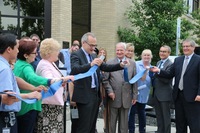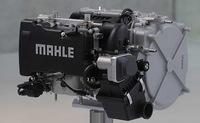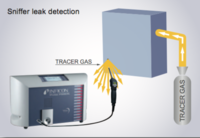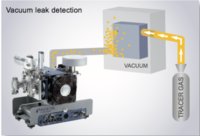15th Tech Crawl, On Site Report: The Auto Channel Looks Into
Auto Technology's Future
By Thom Cannell and Steve Purdy
Senior Editors
The Auto Channel
Michigan Bureau
Annually the Detroit press corps is invited to a daylong deep
dive into a variety of technologies offered by companies represented by a
very active PR firm, AutoCom, which is now in its 20th year. This 15th Tech
Crawl, like the others, attracted a flock of reporters from technical
magazines, newspapers, blogs, popular magazines, and dot-coms like The Auto
Channel. Steve Purdy and Thom Cannell of TACh’s Michigan Bureau again
share their views on technologies ready for prime automotive time,
including some interesting details on how air bags are tested, a timely
topic in the news right now.
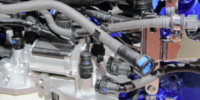
|
Client presentations began with a
highly esoteric, “inside baseball” corporation - ARaymond who
makes all manner of fasteners and quick-connect systems - 100 billion of
them each year for connecting a fuel injector to a fuel rail or simply
pushing a plastic pin into a hole to keep your dashboard or door panel
attached. ARaymond, headquartered in the French Alps, is celebrating its
150th anniversary and the company is now run by the fifth generation of the
founding family. CEO Antoine Raymond was in town doing a tour of all their
facilities with his 82-year-old retired father from whom he took the reins
almost 15 years ago. Celebrating a major expansion of their facility in
nearby Rochester Hills, the ribbon-cutting ceremony featured a ribbon with
a connector in the center so no scissors were needed.

|
Another
AutoCom client, Foretech, makes a variety of niche liquid products.
They’re the Casite Motor Honey, BarsLeak, and Rislone people. What
you probably don’t know about are their singular products like a
coating that’s applied to virtually every pickup rear axle as a
corrosion prevention, or what’s called lapping compound, a gritty
substance that mates differential parts, grinding them as a unit until they
match surfaces to perfection.
Are you racy enough to recall
Cosworth, the racing and powertrain company? They’re now a division
of the huge German MAHLE group and since 2005 has worked on advanced
sensors, turbulent jet ignition (a process relating to perfect internal
combustion in each engine cylinder), engine controls, and test systems.
They brought two exciting ideas, both ready for introduction.
German MAHLE group The
first is a method of using GPS data to help range-extended vehicles
maximize fuel economy while preserving battery charge - think Volt or
Hyundai’s PHEV. If your engine computer
were hooked to the GPS it would know that a hill is approaching so it could
run the internal combustion range extender (and they have a purpose
developed Rex about the footprint of a legal pad) at its most efficient to
recharge the battery on the downhill run and use more electrons on the
uphill. It would also know when you’re in a residential area so
you’d never startle the neighbors with noise. For cities - Amsterdam,
London, Paris - which are rapidly demanding electric-only vehicles,
imposing stiff taxes on combustion engines in the city or banning them, you
could predict driving into a city and preserve battery charge, never paying
the fees. Oh, the tech also delivers fuel economy for fleets like UPS and
others exploring alternative fuel trucks and delivery vehicles.
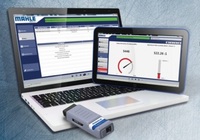
|
MAHLE’s second offering, an almost-available product, is designed for
your local independent mechanic, a guy, girl, or family who has to buy
expensive machines to diagnose the ills in your new vehicle by
communicating with the multiple microprocessors that govern everything from
interior lights to spark at the plugs. Tech Pro, in Beta testing now, is a
compact diagnostic data set that runs on a laptop, desktop, or even
inexpensive tablet computer. Once hooked into the car’s data stream
(every device, manufacturer or aftermarket, hooks in the same way) the
device reads an unbelievable amount of test data. You can flash the
flashers, squirt water out of the window washers, pump the brakes, diagnose
misfires; the list goes on, and on, and on...
Cost to your
independent shop (some dealerships will use Tech Pro instead of buying the
very expensive manufacturer’s test equipment) is $1200 a year and
Cosworth/MAHLE thinks payback will be in three months. Current data sets
cover 2007 Ford, GM, FCA/Chrysler products, soon the Asians, then European
models. Later the product will reach backward to include older models. Tech
Pro uses OEM data, which Cosworth licenses, so it is not a derived data
set. It’s the real thing.
Hella, a company best known for
lighting systems, did little to illuminate our group. Bad pun. They did
spend a great deal of time educating us on how radar systems are used to
help drivers. Things like blind spot warning, assistance in changing lanes,
detecting traffic crossing behind you (including pedestrians and
bicyclists). They also described newer systems, ones designed to let you
know you shouldn’t open your passenger or driver door and crash a
motorcyclist of bicyclist, warnings for tractor-trailer drivers designed to
detect the fools who hide out in blind spots.

|
What we learned was
that 24GHz radar systems (gigahertz, a measure of the radar frequency) are
cheaper because they are currently mass-produced. Newer 77GHz radars
deliver far better resolution of detected objects, but at currently much
higher price. Globally, most manufacturers use 24Ghz radars. However, the
77 GHz band is free for industrial, scientific, and medical use with little
governmental regulations. Also, compared to camera systems, radar cannot
detect contrast and shapes. Camera systems, even infrared systems, are poor
at fog, snow, sleet and other bad weather. Combining radars, even with
camera systems, provides manufacturers with their idea of the best
technology for their buyers.

|
The final presentation came from
INFICON, a small Swiss company that makes leak detection equipment.
Briefly, just about every fuel system part needs to be tested because of
modern fuel injected engines. When Thom Cannell worked at Oldsmobile, his
job was to watch for bubbles as fuel tanks were dunked in water and
pressurized. Today, filling parts with helium and using INFICON’s
sniffers to detect the leaking gas can detect tiny leaks that aren’t
large enough to form bubbles. Currently, air conditioning systems are leak
tested, engines are leak tested, and modern 8-9 speed transmissions are
tested several times to insure quality. Just about every system on the car,
along with many individual components, need to be leak tested and INFICON
does it.
That led to a discussion of air bag testing, a very hot
topic in the news right now.
Air bags are inflated by what are,
essentially, powerful firecrackers. Way sophisticated, but nonetheless,
explosive devices. The problem, described modestly well in nightly news, is
that if water vapor, even a few molecules a day, creep into an air bag
inflator over time the fuel system, the “explosive”, degrades
and burns too rapidly. It goes bang instead of whoosh, producing too much
energy too quickly and sometimes blowing apart that metal hockey puck like
a hand grenade.
One air bag igniter manufacturer, AUTOLIV, is an
INFICON client. They laser weld two steel “hockey pucks”
together to form the igniter body. Inside are measured amounts of hydrogen.
For quality control even those few milligrams of gas contribute to overall
weight, and weighing each igniter prevents a damaged, leaked out unit from
passing a leak test.
A machine puts each igniter into a body, pulls
a vacuum, and if any hydrogen leaks out the unit is failed. Also, a bottle
of hydrogen with a calibrated leak is used to calibrate the unit
periodically. IFICON says that about 300 million igniters are made each
year and about 600 million tests are performed.
After the formal
presentations another AutoCom client, Italian company Alcantara, was
outside with a new Lincoln MKX Black Label showing off their unique product
- an environmentally-friendly, fully sustainable, carbon neutral synthetic
suede used in a variety of auto interior applications – headliners,
seats, door panels, etc. That material is also very big in fashion,
interior design and other applications and it is pretty cool stuff. It
comes from petroleum so no cows had to die to make it – though I
guess we could say some dinosaurs may have been in the mix. The cost is
about the same as leather currently.
We always find it fascinating
to explore and try to understand these high-tech elements that go into
making our cars. AutoCom’s clients, tier-one and tier-two auto
suppliers, ride this wave of blindingly fast scientific development and
fortunately share it all with us periodically, so we can share it with you.
Stay tuned. We’ll be covering more.
© Cannell & Associates and Shunpiker Productions

